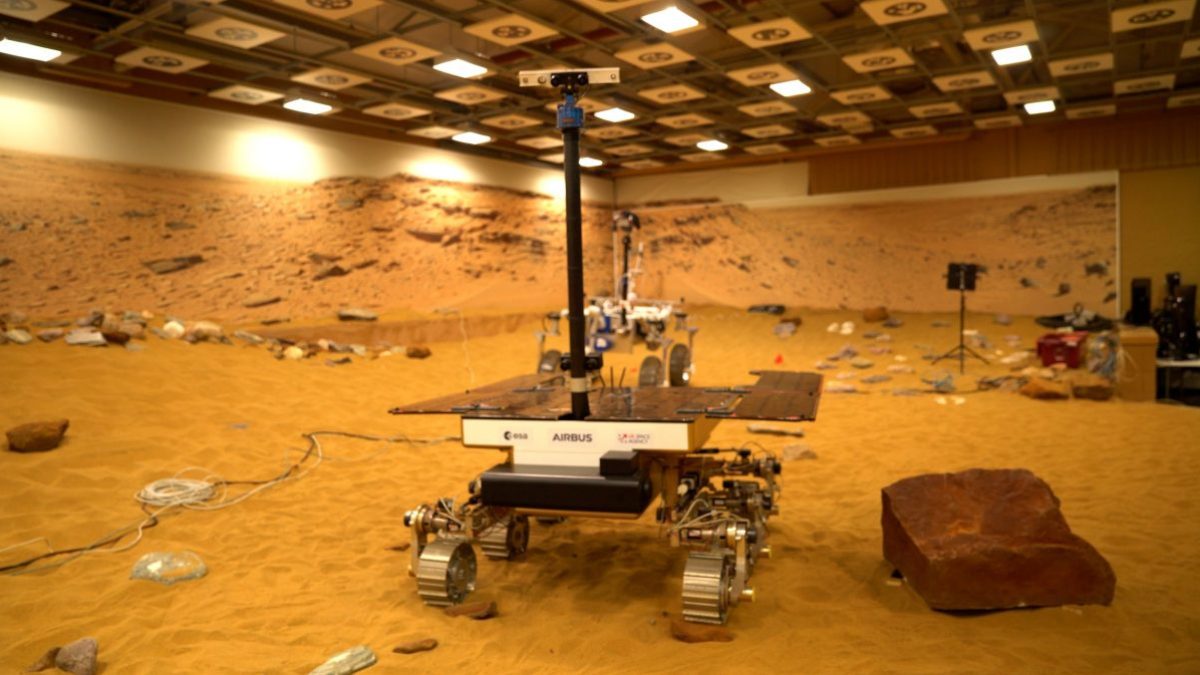A UK laboratory is building the Mars Rover, a robot which will travel to the Red Planet to look for signs of life
STEVENAGE, ENGLAND – In a innocuous factory in Stevenage, with brown brick walls and large grey car park, is the planet Mars.
Well, not quite. This is a laboratory, less than a half-hour train ride from London.
Built by aerospace company Airbus, it has been designed to mimic the conditions of Mars, with zero-moisture orange sand, rocks and bright lights to replicate its shadows.
This lab is used to train the Mars rover, a robot which will soon be sent into space to collect evidence of possible life on Mars.
The site was built in Stevenage more than six decades ago, with the location selected because it was deemed at the time to be outside the blast radius of a nuclear bomb if one was dropped on London.
The current “Mars Yard”, as the lab is known, was opened in 2014, and is used as a test site for the rover.
Named Rosalind Franklin after the British molecular scientist, the rover is set to depart in 2028 as part of the European Space Agency’s ExoMars mission.
However, it won’t be able to land until 2030.
“One of the slightly tricky parts of launching to Mars is that you only have specific times that you can actually launch,” explains Yvonne Pickering, senior autonomous driving and robots engineer at Airbus.
“Earth and Mars are in different orbits. If you launch at the wrong time, Mars could be sort of around the other side of the Sun, which wouldn’t help.”
The launch window opens every 26 months and lasts for 22 days.
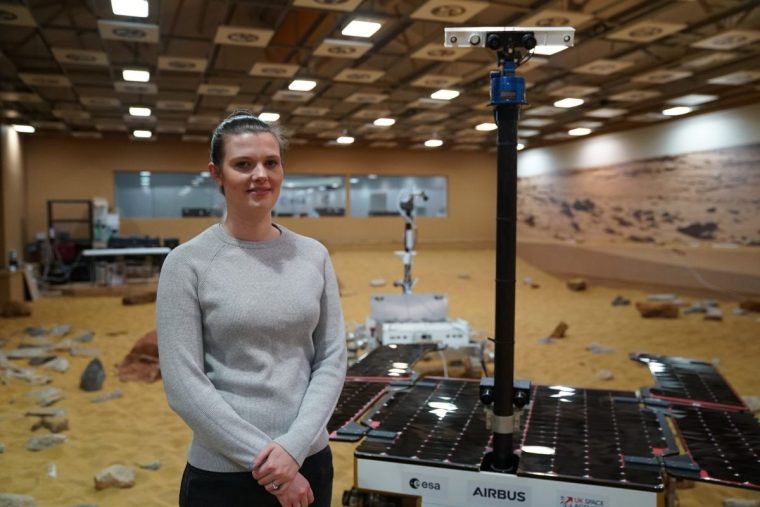 Yvonne Pickering, senior autonomous driving and robots engineer at Airbus (Photo: Robbie Hawken/ The i Paper)
Yvonne Pickering, senior autonomous driving and robots engineer at Airbus (Photo: Robbie Hawken/ The i Paper)
After launch, it will take nine months to reach Mars, but the Red Planet will be embroiled in a mammoth dust storm at the rover’s due date.
The dust would block the solar panels on the rover which give it power, so instead, it will wait in a “parking orbit” for another nine months until the dust clears and it can safely land.
After landing, the rover will begin to dig into the ground to look for organic matter under the surface and analyse the samples it collects.
Last year, scientists found evidence of a large underground reservoir of liquid water on Mars – enough to fill oceans on the planet’s surface.
“The point of the mission is that we’re going to look for signs of life. Mars doesn’t have an atmosphere like Earth does, or a magnetic field, so it doesn’t get the same protection that Earth does.
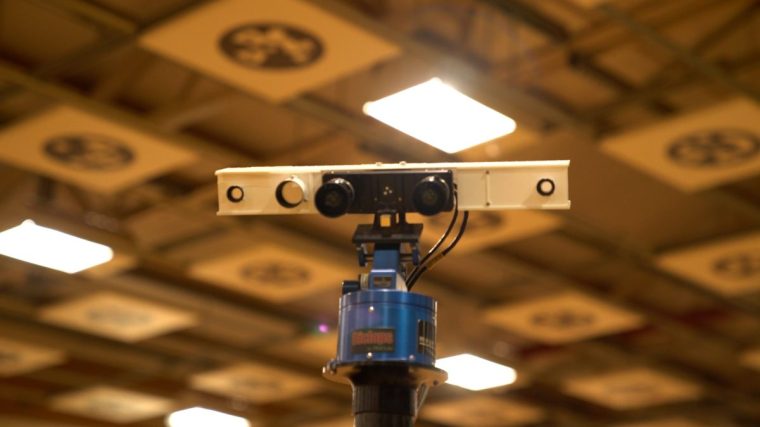 The rover’s eyes help it scan for hazards in front of it (Photo: Robbie Hawken/ The i Paper)
The rover’s eyes help it scan for hazards in front of it (Photo: Robbie Hawken/ The i Paper)
“Radiation hits the surface of Mars and it will destroy everything on the top layers. So we’re going to have to drill down into roughly around two metres, which is where we think that we may still be able to find some organic matter that hasn’t been destroyed.
“The drill will go down roughly two metres. It will pick up a sample, bring it back up and put it on board into a middle area that we call the bathtub area of the rover. In there, it will then do a whole bunch of scientific tests on that sample to work out whether that contains any kind of organic material.”
The organic material the rover collects isn’t expected to be alive, but scientists hope it could be evidence of life which was once present on Mars.
The robot will send its results back to Earth via satellite.
But navigating the Red Planet is no mean feat.
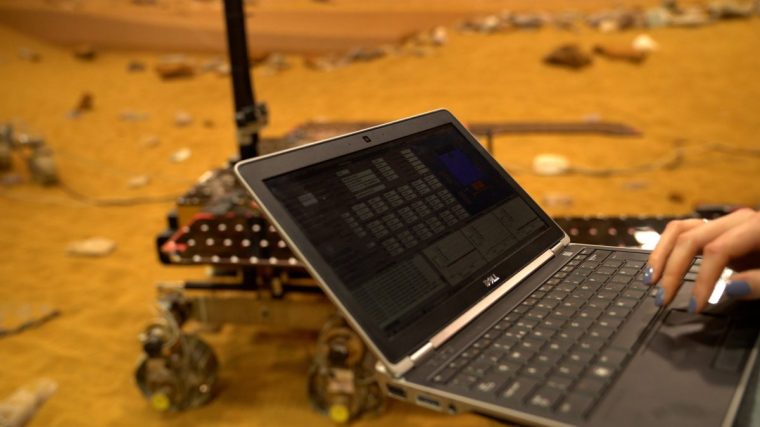 Pickering can control the rover from a laptop. When on Mars, it will be sent to locations by scientists on Earth (Photo: Robbie Hawken/ The i Paper)
Pickering can control the rover from a laptop. When on Mars, it will be sent to locations by scientists on Earth (Photo: Robbie Hawken/ The i Paper)
If Mars and Earth are on opposite sides of their orbit, there can be a time lag of up to 45 minutes between the two planets.
This makes it almost impossible for a human to safely steer the rover, because it would be likely to have already hit an obstacle by the time its human handlers have spotted it and tried to change course.
Instead, they have built the rover to drive itself across the Red Planet.
“The scientists could tell us where they would like to drill, and we will tell the rover ‘we want you to go to this point’, and the rover will have to find its own path to get there,” Yvonne says.
It moves, however, under heavy restrictions, with limits on what size rock it can roll over or how steep an incline it can travel up.
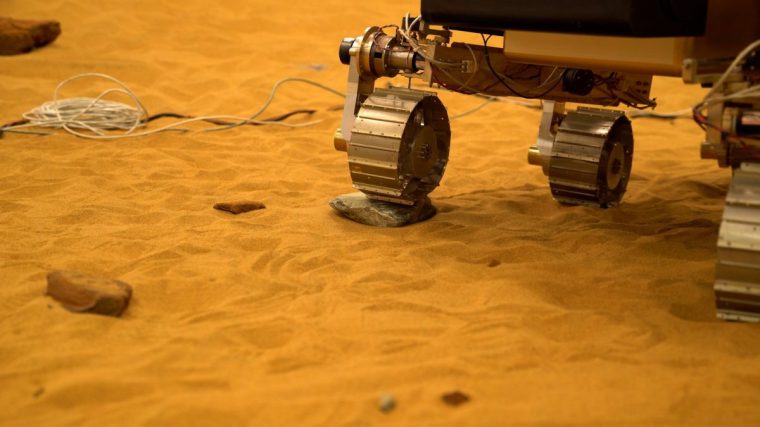 The rover’s wheels are designed to be flexible but with strong grip, to avoid it toppling over rocks on Mars (Photo: Robbie Hawken/ The i Paper)
The rover’s wheels are designed to be flexible but with strong grip, to avoid it toppling over rocks on Mars (Photo: Robbie Hawken/ The i Paper)
“It has to make sure it keeps itself safe. That’s really key,” Pickering says.
“We have no righting mechanisms [for] if the rover fell over. If the rover went fully over onto its side, that is game over. The problem is, it’s so difficult to think of all the possible ways that the rover could get itself stuck, and then try and have something that could combat that, the better idea is to just keep the rover safe.
“A lot of that makes it quite complicated for the rover to actually work out a safe path. So it does go quite slowly.”
It travels around 2cm a second, stopping and taking three camera images, analysing the terrain in front of it, finding a path, travelling for 2.5m and then stopping.
“It can take a little while for the rover to make progress, but we always make sure that we’re safe,” she says.
Does Yvonne believe there’s life on Mars? She stops to think.
“Mars has a lot of the same characteristics that we think Earth has shown, like a lot of water features from rivers,” she says. “A lot of those signs would be very positive ones that life did exist.”
